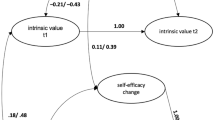Abstract
The educational community lacks tools for assessing the nonacademic growth of students — their growth as persons and as social beings. This paper describes the development of an attitude inventory based on an interdisciplinary model of psychosocial maturity. The Psychosocial Maturity Inventory, a self-report instrument, is comprised of nine subscales and is suited for the assessment of youngsters in the approximate age range 11–18. Among the studies reviewed are ones which (1) specify at various age levels the internal consistency of the subscales, (2) report the association between the subscales and various measures of academic achievement, and (3) describe the relationship of the subscales to other measures of personality such as “faking good,” anxiety, and self-esteem. Factor analyses of the Inventory provide an empirical base for testing the proposed theoretical structure of psychosocial maturity.
Similar content being viewed by others
References
Andersson, B.-E. (1969).Studies in Adolescent Behaviour, Almqvist and Wiksells, Uppsala.
Bond, L., Josselson, R., Greenberger, E., and McConochie, D. (1974). On the Validity of the Psychosocial Maturity Inventory: The Social Adequacy Subscales and Social Action, Report No. 177, Center for Social Organization of Schools, Johns Hopkins University, Baltimore.
Coleman, J. S. (1961).The Adolescent Society, Free Press, New York.
Dunnette, M. D. (1966).Personnel Selection and Placement, Wadsworth, Belmont, Calif.
Greenberger, E. (1972). Psychosocial Maturity or Social Desirability, Report No. 131, Center for Social Organization of Schools, Johns Hopkins University, Baltimore.
Greenberger, E., and Sørensen, A. B. (1974). Toward a concept of psychosocial maturity.J. Youth Adolesc. 3: 329–358.
Greenberger, E., Knerr, C., Knerr, B., and Brown, J. B. (1974). The Measurement and Structure of Psychosocial Maturity, Report No. 170, Center for Social Organization of Schools, Johns Hopkins University, Baltimore.
Harman, H. H., and Jones, W. H. (1966). Factor analysis by minimizing residuals (minres).Psychometrika 31: 351–368.
Jacob, P. (1958).Changing Values in College: An Exploratory Study of the Impact of College Teaching, Harper, New York.
Josselson, R., Greenberger, E., and McConochie, D. (1974a). On the Validity of the Psychosocial Maturity Scales: Relationship to Teacher Ratings, Report No. 171, Center for Social Organization of Schools, Johns Hopkins University, Baltimore.
Josselson, R., Greenberger, E., and McConochie, D. (1974b). On the Validity of the Psychosocial Maturity Inventory: Relationship to Teacher Nominations, Report No. 183, Center for Social Organization of Schools, Johns Hopkins University, Baltimore.
Josselson, R., Greenberger, E., and McConochie, D. (1975). On the Validity of the Psychosocial Maturity Inventory: Relationship to Measures of Personal Well-being, Report No. 186, Center for Social Organization of Schools, Johns Hopkins University, Baltimore.
Kaiser, H. F. (1958). The varimax criterion for analytic rotation in factor analyses.Psychometrika 23: 187–200.
Kandel, D. B., and Lesser, G. S. (1972).Youth in Two Worlds, Jossey-Bass, San Francisco.
Kuder, G. F., and Richardson, M. W. (1937). The theory of the estimation of test reliability.Psychometrika 2: 151–160.
Lacey, C. (1970).Hightown Grammar: The School as a Social System, The University Press, Manchester, England.
McDill, E., and Coleman, J. S. (1965). Family and peer influences on college plans of high school students.Sociol. Educ. 38: 112–126.
Newcomb, T. (1943).Personality and Social Change, Holt, Rinehart and Winston, New York.
Rosenberg, M. (1965).Society and the Adolescent Self-image, Princeton University Press, Princeton, N.J.
Sanford, R. N. (ed.) (1962).The American College, Wiley, New York.
Tilton, J. W. (1937). The measurement of overlapping.J. Educ. Psychol. 28: 656–662.
Welsh, G. S. (1956). Factor dimensions A and R. In Welsh, G. S. and Dahlstrom, W. G. (eds.),Basic Readings on the MMPI in Psychology and Medicine, University of Minnesota Press, Minneapolis.
Author information
Authors and Affiliations
Additional information
Preparation of this paper was supported by funds from the National Institute of Education, Contract No. NE-C-00-3-0013.
Received Ph.D. in clinical psychology from Radcliffe College. Main interest: personality development from childhood through adolescence.
Received Ph.D. in psychology from the University of Michigan. Main research interests: the psychology of adolescence and the psychology of women.
Received Ph.D. in psychology from the University of Maryland. Main interests: measurement theory and the measurement of human performance.
Rights and permissions
About this article
Cite this article
Greenberger, E., Josselson, R., Knerr, C. et al. The measurement and structure of psychosocial maturity. J Youth Adolescence 4, 127–143 (1975). https://doi.org/10.1007/BF01537437
Received:
Issue Date:
DOI: https://doi.org/10.1007/BF01537437




